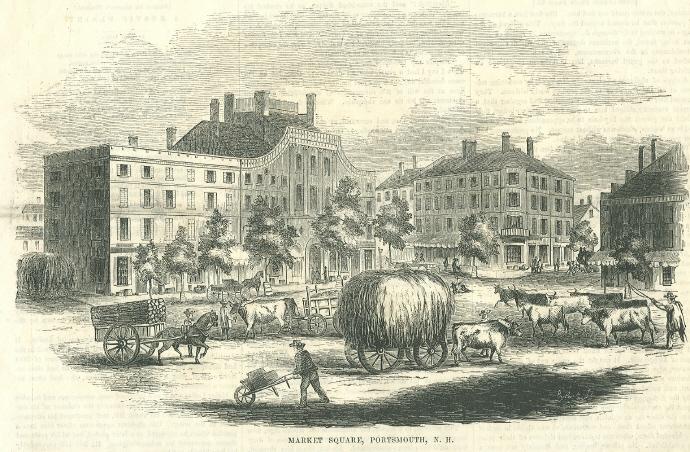|
Atlantic Shore Line Railway
The Atlantic Shore Line (ASL) was an electric trolley line providing passenger and freight service to many towns in York County, Maine, in the United States. The ASL was the second-longest trolley line in Maine, encompassing over of track. Beginnings A charter for the Atlantic Shore Line Electric Railroad was first issued in March 1893 by the Maine legislature. The charter allowed for the building of an electric railroad from Biddeford, through the towns of Kennebunkport and Wells, to York Beach. In October 1899, articles of association were filed for the Atlantic Shore Line Railway by a group which included officers of the Mousam River Railroad and the Sanford & Cape Porpoise Railway. The charter of the railroad was approved on February 9, 1900, following a hearing at the State House in Augusta. Route From the Town House Square carbarn in Kennebunkport (the site currently across the street from the Kennebunkport Historical Society), ASL trolley service connected Cape Porp ... [...More Info...] [...Related Items...] OR: [Wikipedia] [Google] [Baidu] |
Interurban
The Interurban (or radial railway in Europe and Canada) is a type of electric railway, with streetcar-like electric self-propelled rail cars which run within and between cities or towns. They were very prevalent in North America between 1900 and 1925 and were used primarily for passenger travel between cities and their surrounding suburban and rural communities. The concept spread to countries such as Japan, the Netherlands, Switzerland, Belgium, Italy and Poland. Interurban as a term encompassed the companies, their infrastructure, their cars that ran on the rails, and their service. In the United States, the early 1900s interurban was a valuable economic institution. Most roads between towns and many town streets were unpaved. Transportation and haulage was by horse-drawn carriages and carts. The interurban provided reliable transportation, particularly in winter weather, between the town and countryside. In 1915, of interurban railways were operating in the United States an ... [...More Info...] [...Related Items...] OR: [Wikipedia] [Google] [Baidu] |
Ogunquit, Maine
Ogunquit ( ) is a resort town in York County, Maine. As of the 2020 census, its population was 1,577. Ogunquit is part of the Portland– South Portland–Biddeford, Maine Metropolitan Statistical Area. History Ogunquit, which means "beautiful place by the sea" in the indigenous Abenaki language, was first a village within Wells, which was settled in 1641. The first sawmill was established in 1686, and shipbuilding developed along the tidal Ogunquit River. Local shipwrights built schooners, brigs and dories. At what was then called Fish Cove, near the unnavigable Josias River, fishing was a major livelihood. But the cove was unprotected by a headland or breakwater from Atlantic storms, so fishermen had to protect their boats by hauling them ashore each night. Resolving to create a safe anchorage, they formed the Fish Cove Harbor Association, and dug a channel across land they purchased to connect Fish Cove with the Josias River. When the trench was complete, erosion helped ... [...More Info...] [...Related Items...] OR: [Wikipedia] [Google] [Baidu] |
Defunct New Hampshire Railroads
{{Disambiguation ...
Defunct (no longer in use or active) may refer to: * ''Defunct'' (video game), 2014 * Zombie process or defunct process, in Unix-like operating systems See also * * :Former entities * End-of-life product * Obsolescence Obsolescence is the state of being which occurs when an object, service, or practice is no longer maintained or required even though it may still be in good working order. It usually happens when something that is more efficient or less risky r ... [...More Info...] [...Related Items...] OR: [Wikipedia] [Google] [Baidu] |
Interurban Railways In Maine
The Interurban (or radial railway in Europe and Canada) is a type of electric railway, with streetcar-like electric self-propelled rail cars which run within and between cities or towns. They were very prevalent in North America between 1900 and 1925 and were used primarily for passenger travel between cities and their surrounding suburban and rural communities. The concept spread to countries such as Japan, the Netherlands, Switzerland, Belgium, Italy and Poland. Interurban as a term encompassed the companies, their infrastructure, their cars that ran on the rails, and their service. In the United States, the early 1900s interurban was a valuable economic institution. Most roads between towns and many town streets were unpaved. Transportation and haulage was by horse-drawn carriages and carts. The interurban provided reliable transportation, particularly in winter weather, between the town and countryside. In 1915, of interurban railways were operating in the United States ... [...More Info...] [...Related Items...] OR: [Wikipedia] [Google] [Baidu] |
Defunct Maine Railroads
{{Disambiguation ...
Defunct (no longer in use or active) may refer to: * ''Defunct'' (video game), 2014 * Zombie process or defunct process, in Unix-like operating systems See also * * :Former entities * End-of-life product * Obsolescence Obsolescence is the state of being which occurs when an object, service, or practice is no longer maintained or required even though it may still be in good working order. It usually happens when something that is more efficient or less risky r ... [...More Info...] [...Related Items...] OR: [Wikipedia] [Google] [Baidu] |
Seashore Trolley Museum
Seashore Trolley Museum, located in Kennebunkport, Maine, United States, is the world's first and largest museum of mass transit vehicles. While the main focus of the collection is trolley cars (trams), it also includes rapid transit trains, Interurban cars, trolley buses, and motor buses. The Seashore Trolley Museum is owned and operated by the New England Electric Railway Historical Society (NEERHS).Young, Andrew D. (1997). ''Veteran & Vintage Transit'', pp. 43–48. St. Louis: Archway Publishing. . Of the museum's collection of more than 350 vehicles, ten trolley, and railroad cars that historically operated in Maine were listed on the National Register of Historic Places in 1980, as Maine Trolley Cars. History Theodore F. Santarelli de Brasch and Osmond Richard Cummings were two of the founders of the museum, which was initially operated as the Seashore Electric Railway. Santarelli graduated from Harvard University and led the museum until he died in 1987; Cummings, a ... [...More Info...] [...Related Items...] OR: [Wikipedia] [Google] [Baidu] |
Right-of-way (transportation)
A right-of-way (ROW) is a right to make a way over a piece of land, usually to and from another piece of land. A right of way is a type of easement granted or reserved over the land for transportation purposes, such as a highway, public footpath, rail transport, canal, as well as electrical transmission lines, oil and gas pipelines. In the case of an easement, it may revert to its original owners if the facility is abandoned. This American English term is also used to denote the land itself. A right of way is granted or reserved over the land for transportation purposes, usually for private access to private land and, historically for a highway, public footpath, rail transport, canal, as well as electrical transmission lines, oil and gas pipelines.Henry Campbell Black: ''Right-of-way.'' In''A law dictionary containing definitions of the terms and phrases of American and English jurisprudence, ancient and modern: and including the principal terms of international, constitutio ... [...More Info...] [...Related Items...] OR: [Wikipedia] [Google] [Baidu] |
Kittery Point, Maine
Kittery Point is a census-designated place (CDP) in the town of Kittery, York County, Maine, United States. First settled in 1623, Kittery Point traces its history to the first seafarers who colonized the shore of what became Massachusetts Bay Colony and later the State of Maine. Located beside the Atlantic Ocean, it is home to Fort McClary State Historic Site, and Fort Foster Park on Gerrish Island. Cutts Island is home to Seapoint Beach and the Brave Boat Harbor Division of the Rachel Carson National Wildlife Refuge. Kittery Point is part of the Portland– South Portland–Biddeford, Maine Metropolitan Statistical Area. The population was 1,012 at the 2010 census. History Settled as early as 1623, the southern part of Kittery was once called Champernowne's after Sir Francis Champernowne, a prominent merchant adventurer and cousin of Sir Ferdinando Gorges, the prime mover behind settlement north of the Massachusetts Bay Colony. Nicholas Shapleigh built the first hou ... [...More Info...] [...Related Items...] OR: [Wikipedia] [Google] [Baidu] |
Portsmouth, New Hampshire
Portsmouth is a city in Rockingham County, New Hampshire, United States. At the 2020 census it had a population of 21,956. A historic seaport and popular summer tourist destination on the Piscataqua River bordering the state of Maine, Portsmouth was formerly the home of the Strategic Air Command's Pease Air Force Base, since converted to Portsmouth International Airport at Pease. History American Indians of the Abenaki and other Algonquian languages-speaking nations, and their predecessors, inhabited the territory of coastal New Hampshire for thousands of years before European contact. The first known European to explore and write about the area was Martin Pring in 1603. The Piscataqua River is a tidal estuary with a swift current, but forms a good natural harbor. The west bank of the harbor was settled by European colonists in 1630 and named Strawbery Banke, after the many wild strawberries growing there. The village was protected by Fort William and Mary on what is now ... [...More Info...] [...Related Items...] OR: [Wikipedia] [Google] [Baidu] |
Dover, New Hampshire
Dover is a city in Strafford County, New Hampshire, United States. The population was 32,741 at the 2020 census, making it the largest city in the New Hampshire Seacoast region and the fifth largest municipality in the state. It is the county seat of Strafford County, and home to Wentworth-Douglass Hospital, the Woodman Institute Museum, and the Children's Museum of New Hampshire. Etymology First recorded in its Latinised form of ''Portus Dubris'', the word "Dover" derives from the Brythonic word for "waters" (''dwfr'' in Middle Welsh). The same element is present in the word's French (''Douvres'') and Modern Welsh (''Dofr'') forms. History Settlement The first known European to explore the region was Martin Pring from Bristol, England, in 1603. In 1623, William and Edward Hilton settled at Pomeroy Cove on Dover Point, making Dover the oldest permanent settlement in New Hampshire, and seventh in the United States. One of the colony's four original townships, it then includ ... [...More Info...] [...Related Items...] OR: [Wikipedia] [Google] [Baidu] |
South Berwick, Maine
South Berwick is a town in York County, Maine, United States. The population was 7,467 at the 2020 census. South Berwick is home to Berwick Academy, a private, co-educational university-preparatory day school founded in 1791. The town was set off from Berwick in 1814, followed by North Berwick in 1831. It is part of the Portland– South Portland–Biddeford, Maine metropolitan statistical area. The primary village in the town is the South Berwick census-designated place. History The area was called Newichawannock by the Abenaki Indians, meaning "river with many falls," a reference to the Salmon Falls River. It was first settled by Europeans about 1631 as a part of Kittery known as Kittery North Parish. Near the confluence with the Great Works River, Ambrose Gibbons built the Great House at Newichawannock, a palisaded trading post, to exchange goods with the Indians. In 1634, William Chadbourne, James Wall, and John Goddard arrived from England aboard the ship ''Pied C ... [...More Info...] [...Related Items...] OR: [Wikipedia] [Google] [Baidu] |
Eliot, Maine
Eliot is a town in York County, Maine, United States. Originally settled in 1623, it was formerly a part of Kittery, Maine, to its east. After Kittery, it is the next most southern town in the state of Maine, lying on the Piscataqua River across from Portsmouth and Newington, New Hampshire. The population was 6,717 at the 2020 census. It is part of the Portland– South Portland–Biddeford, Maine metropolitan statistical area. Eliot is home to Ambush Rock, Green Acre, and the Raitt Homestead Farm Museum. History Founding Today's town of Eliot was formerly the Middle Parish of the town Kittery, Maine,Old Kittery and Her Families", Everett Stackpole, 1903 originally part of the royal grant to Sir Ferdinando Gorges known as the Piscataqua Plantation. Kittery was incorporated in 1647, today distinguishing itself as "the oldest incorporated town in Maine." While this may be so, settlements upriver on the north side of the Piscataqua River in today's Eliot were established ... [...More Info...] [...Related Items...] OR: [Wikipedia] [Google] [Baidu] |








